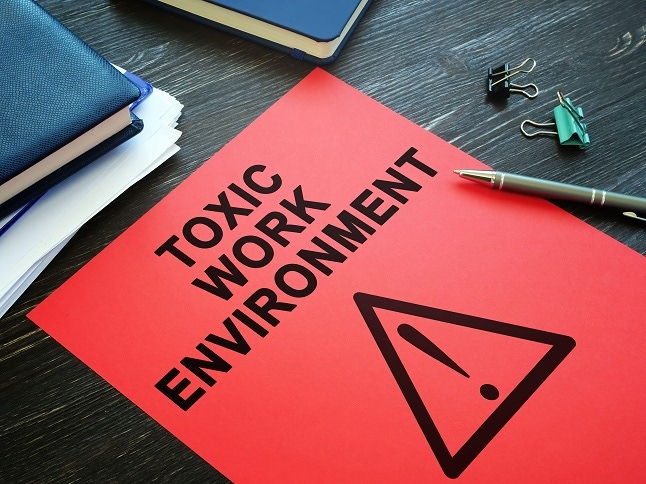Tech layoffs intensify perception of a toxic workplace, 45% of respondents in a new study said. Leaders know how to address the problem -- are they doing enough?

The cold reality of a macroeconomic climate that has driven thousands of tech industry layoffs is increasing the perception of toxicity in the workplace, according to a report from learning and training solutions providers TalentLMS and Culture Amp.
The companies surveyed more than 1,000 employees and found that respondents mostly blame leadership and senior management for creating a more toxic workplace. However, nearly half (49%) of the surveyed employees said they won’t say or do anything in response to toxic behaviors.
Dimitris Tsingos, co-founder of Epignosis and TalentLMS, told InformationWeek the findings are alarming, but there’s hope for an antidote for workplace toxicity. “The results were very eye-opening,” Tsingos says. “It seems that toxicity dominates the workplace in many companies. It seems that after the pandemic, the emotional connection between employees and employers is often broken. And we can see the manifestation of this broken link between companies and employees in the perception of toxicity in the workplace.
The report says while 84% of leaders recognize a need to improve their culture, 43% of their employees say leadership is turning a blind eye to toxic behaviors, and 47% say there’s a lack of leadership and accountability at their company.
“The good news is that it becomes evident that investing in learning and development of employees becomes one of the best things that an organization can do to make sure they don’t have a toxic workplace,” Tsingos says. “In the economy of knowledge, investing, learning, and development are the key means to improve culture.”
Addressing Toxicity by Focusing on Hybrid Tools and Diversity
The report details five distinct main contributors to toxic culture, including expecting employees to work longer hours or weekends without additional pay, a lack of transparency and communication from management and leadership, a lack of consistency and courtesy, backstabbing behavior, and gossip.
Tsingos says the pandemic isolation contributed to the sense of toxicity as employers were trying to define their newly remote work culture. But hybrid work also presented an opportunity to build new relationships and create more tools. “We’ve all been in offices where the environment was toxic,” he says. “Remote work can impose another barrier and you don’t get to spend time with the rest of the people on your team. However, it’s also an opportunity to offer a much more flexible learning environment. It’s an opportunity to use tools that facilitate better communication. It’s an opportunity to promote more diversity.”
A company’s diversity, equity, and inclusion (DEI) efforts can reduce toxicity, the report found. “That was one of the biggest findings,” Tsingos says. “You need to have inclusive organizations that are diverse and training. During the pandemic, we did have a real breakthrough and more companies started embracing a real DEI philosophy.”
About 45% of respondents thought cultivating an inclusive and diverse environment reduced toxicity in the office. “The atmosphere of acceptance for different kinds of diversity enhances safety, fairness, and belonging,” the report says.
The Role of Senior Leadership in a Healthy Workplace Culture
Joel Davies, senior people scientist at Culture Amp, says senior leadership hold the keys to creating a better work culture. “There is a common belief that ‘people leave managers, not companies,’ but we have found perceptions of senior leadership tend to be more important for employee engagement and commitment than perceptions of one’s direct manager. Senior leaders are role models, whether they like it or not. The way they behave at work creates powerful social norms that can impact how the rest of the organizations behaves.”
In a tough economic environment, Tsingos says transparency goes a long way to building a positive workplace perception. “We’re living in an era of uncertainty in the financial markets,” he says. “This pressure creates toxicity. How do you deal with that. You deal with that with transparency. You deal with openness, and you deal with it by investing in your people. You might have a big company laying off thousands of people -- but there are some people who may come back and who are thankful for the transparency. Because that employer was investing in them and treating them nicely.”
Getting out of the executive suite and getting to know your team is crucial, Tsingos says. “We must acknowledge the reality that many people in the C-suite live in a bubble,” he says. “And they don’t understand the everyday life of the average team member. The successful ones manage to go out of the bubble and get a real sense of the experience of their team members. This distinguishes a successful C-suite level leader from an average one.”
Employees need to have the freedom and willingness to report toxic behaviors to senior staff, Tsingos says. “In a contemporary organization, people need to feel like they can talk about their concerns in a constructive way. They must be able to speak up.”
What to Read Next:
Cisco CIO Fletcher Previn on the Hybrid Workplace & Exploring AI
Achieving Diversity: The Role IT Plays in DEI Recruiting
Women in IT: Progress in Workforce Culture, But Problems Persist
About the Author(s)
You May Also Like







